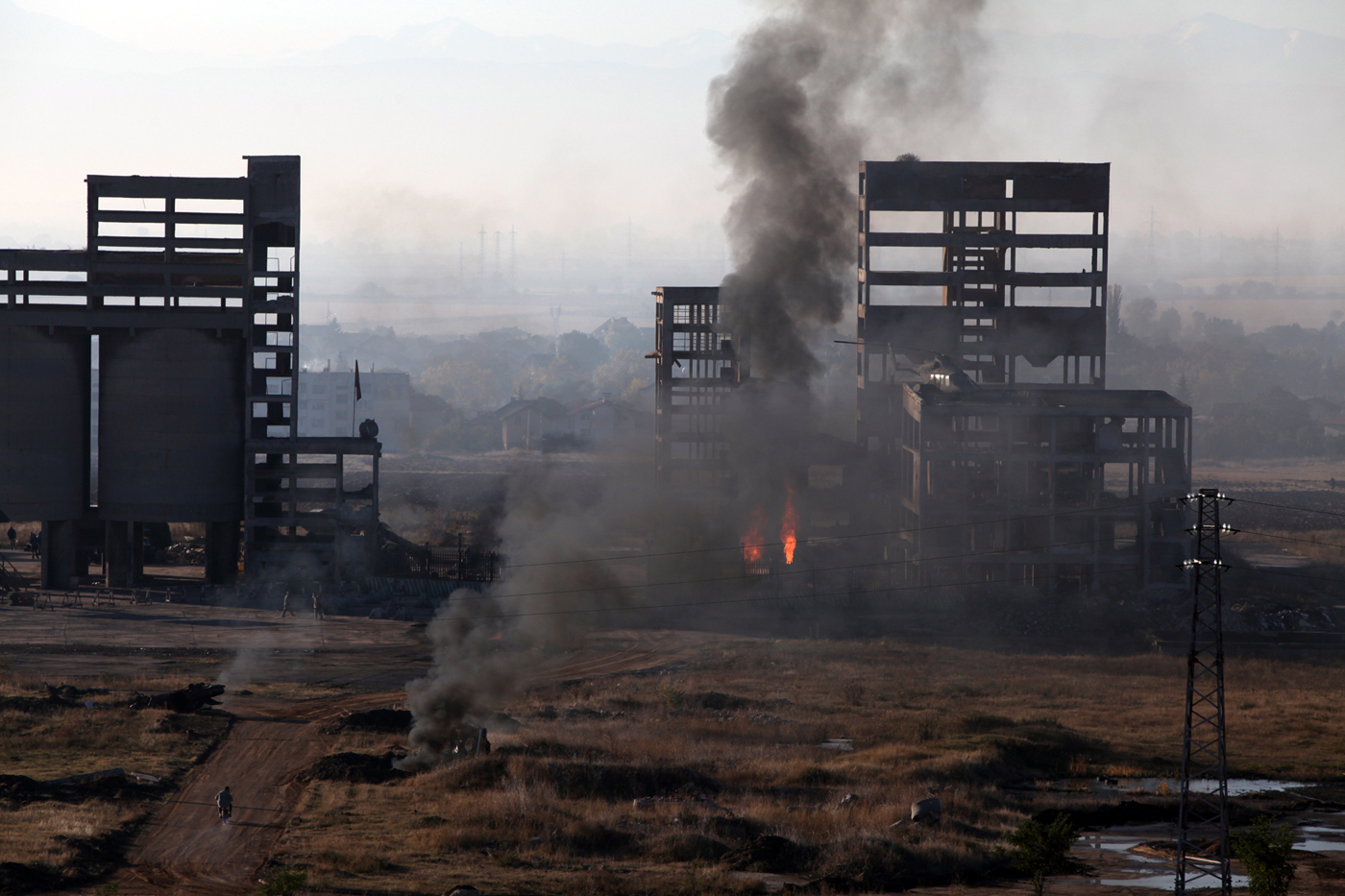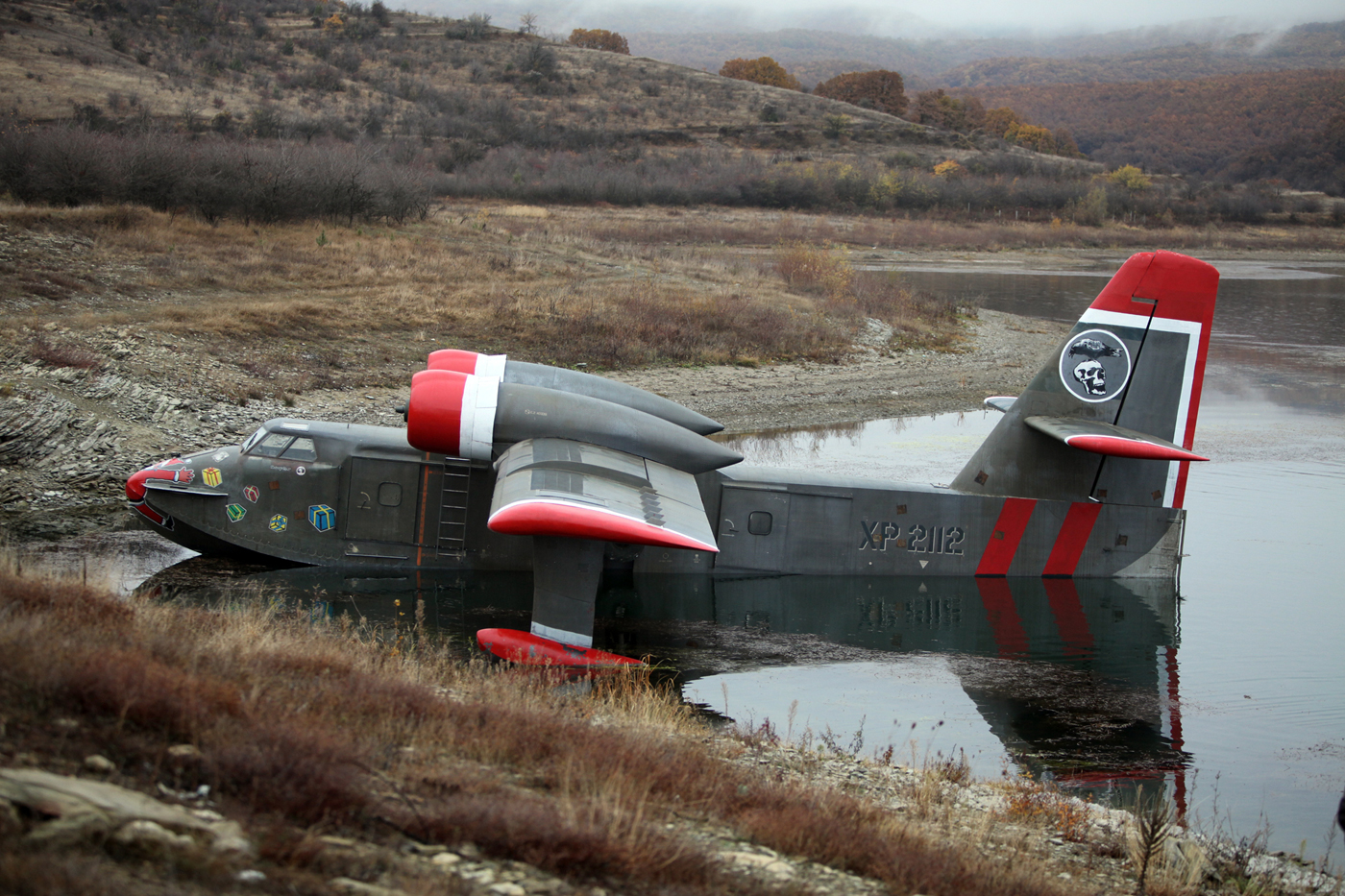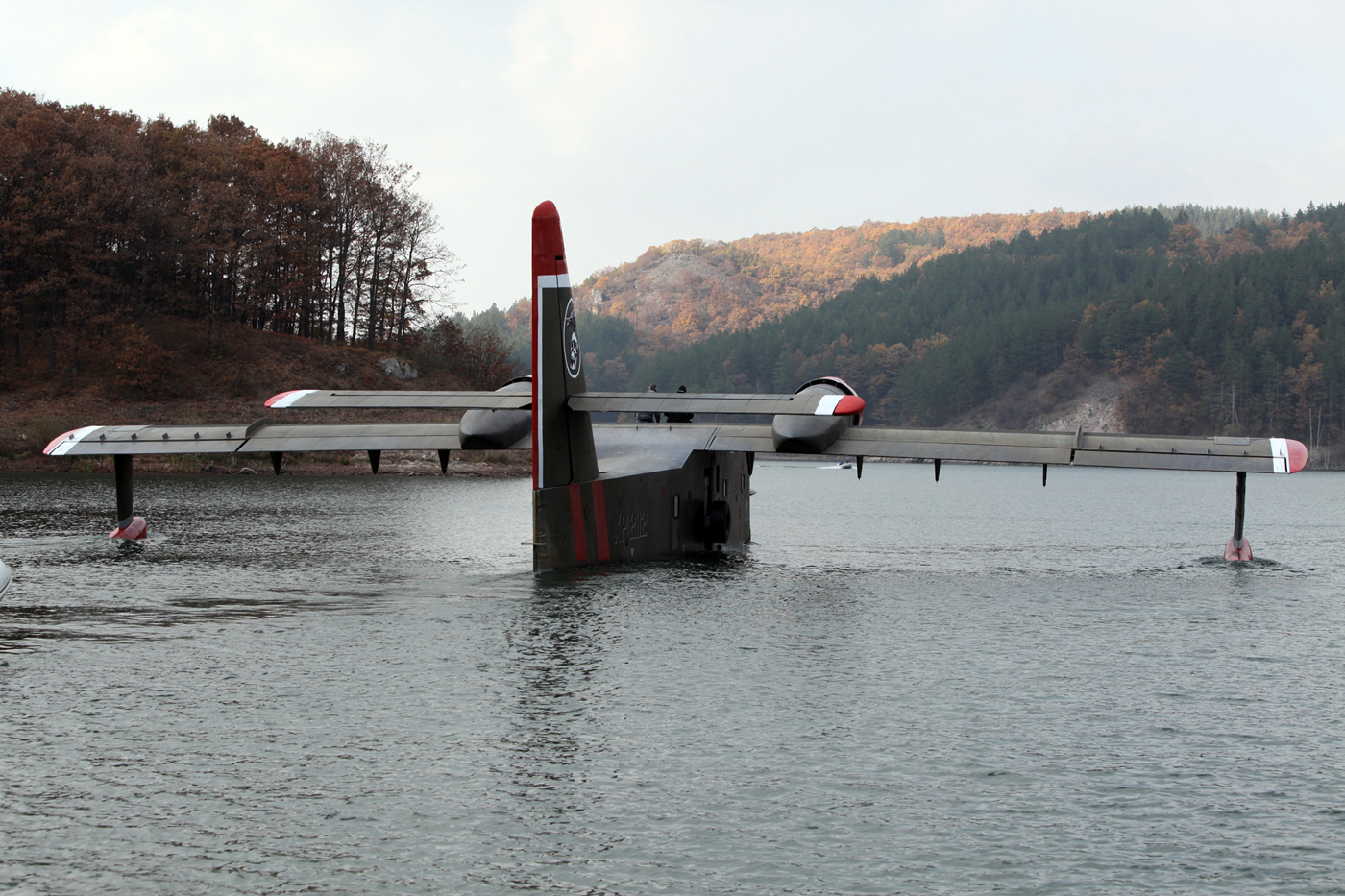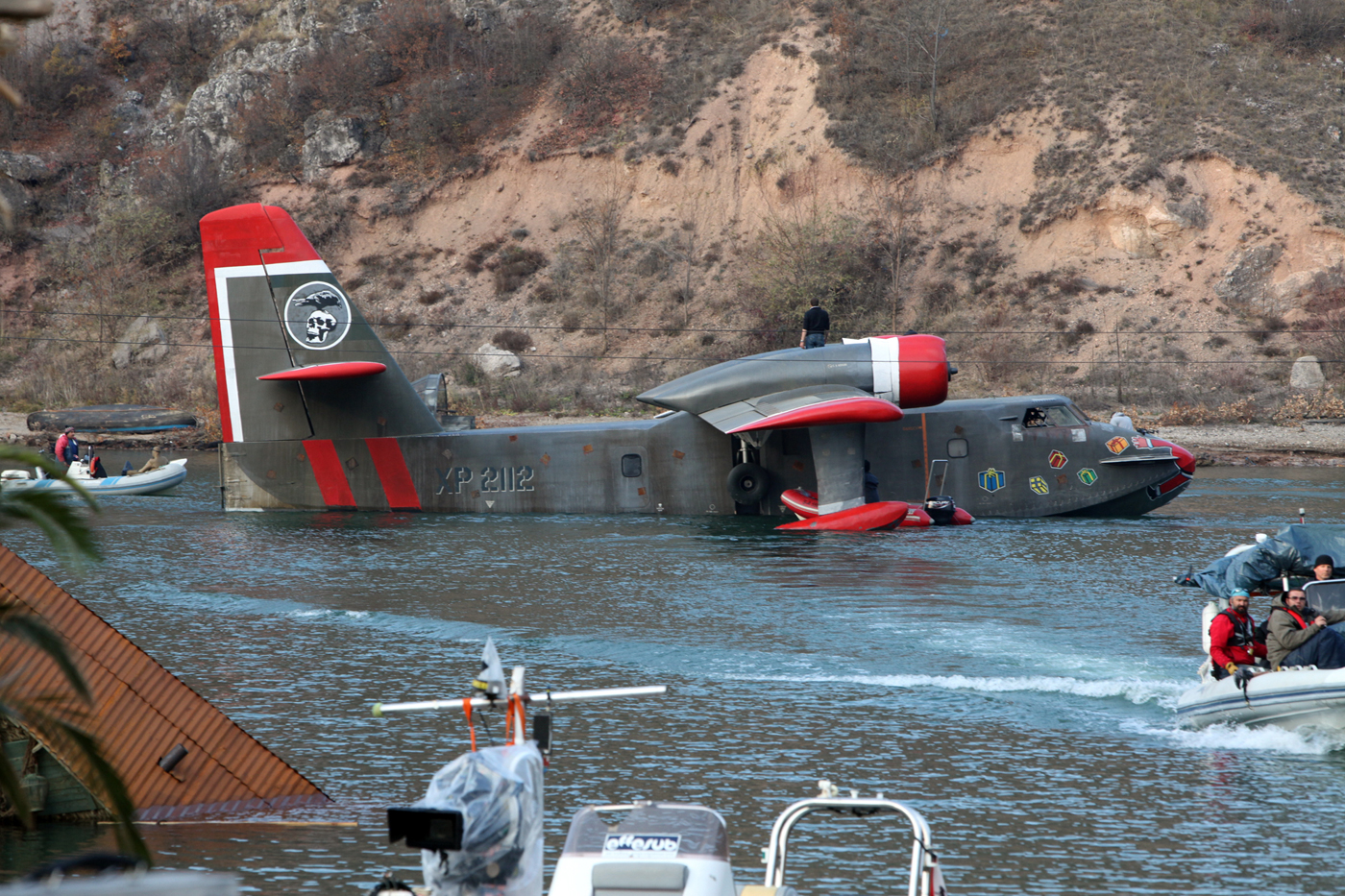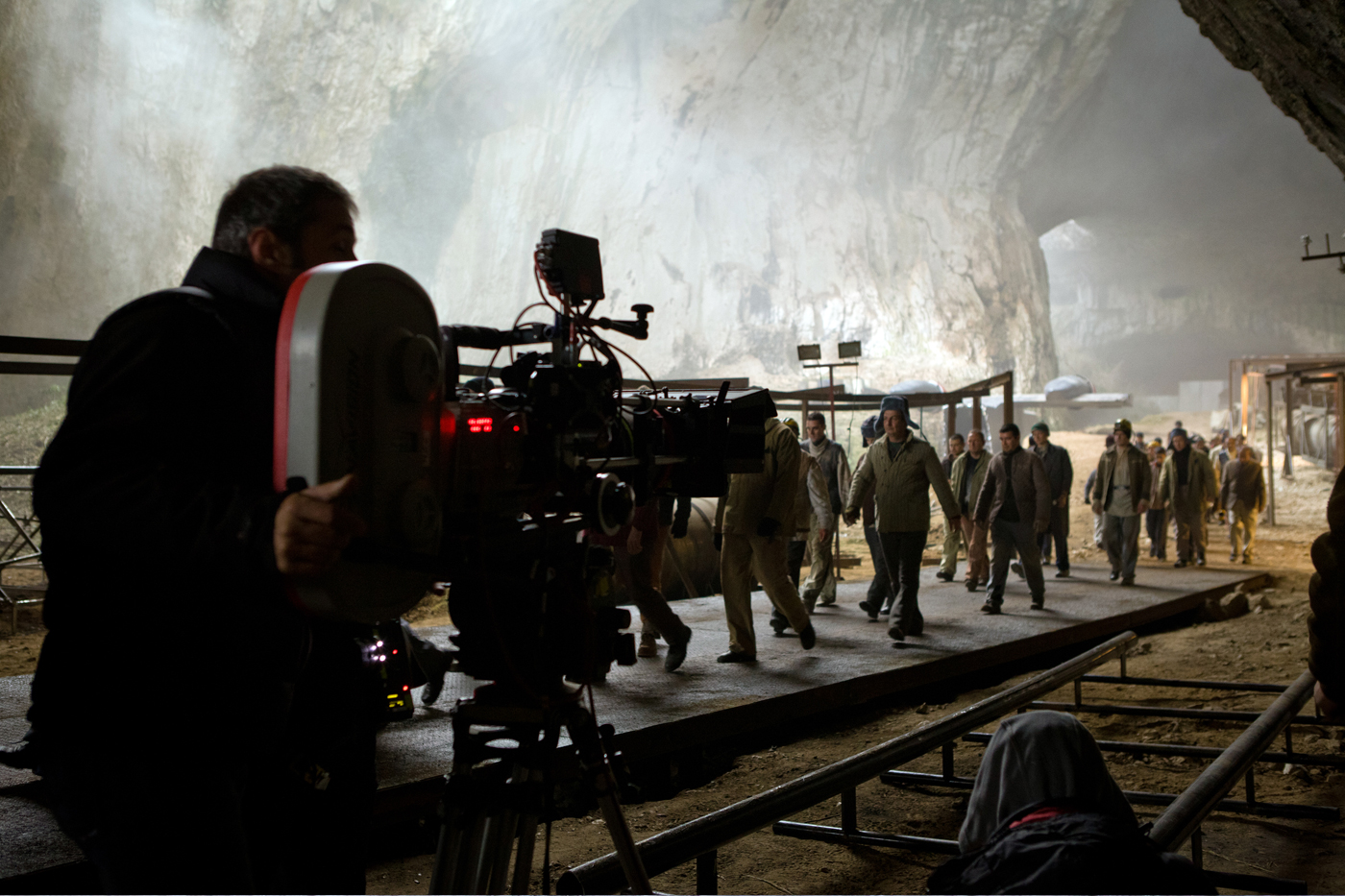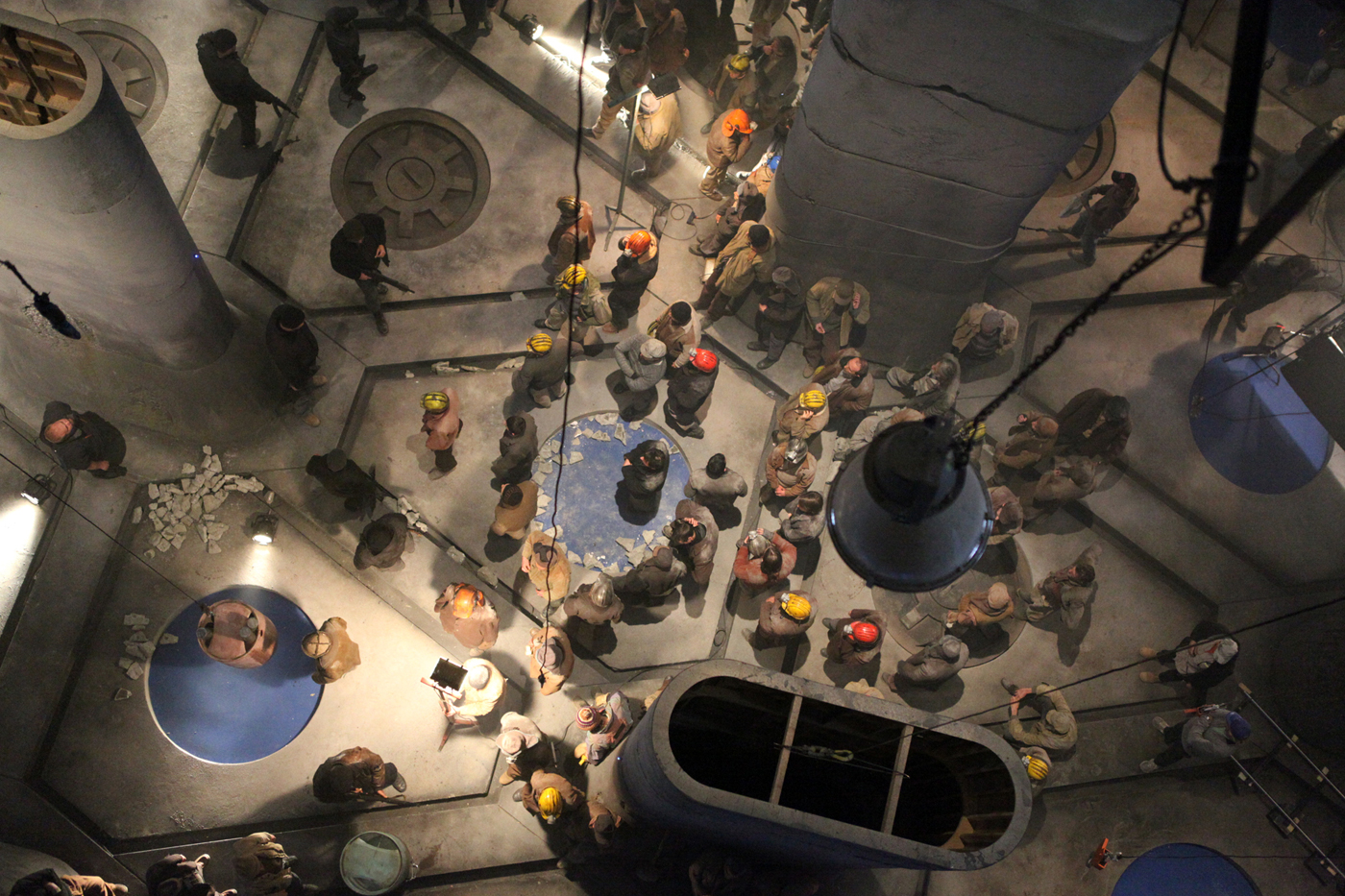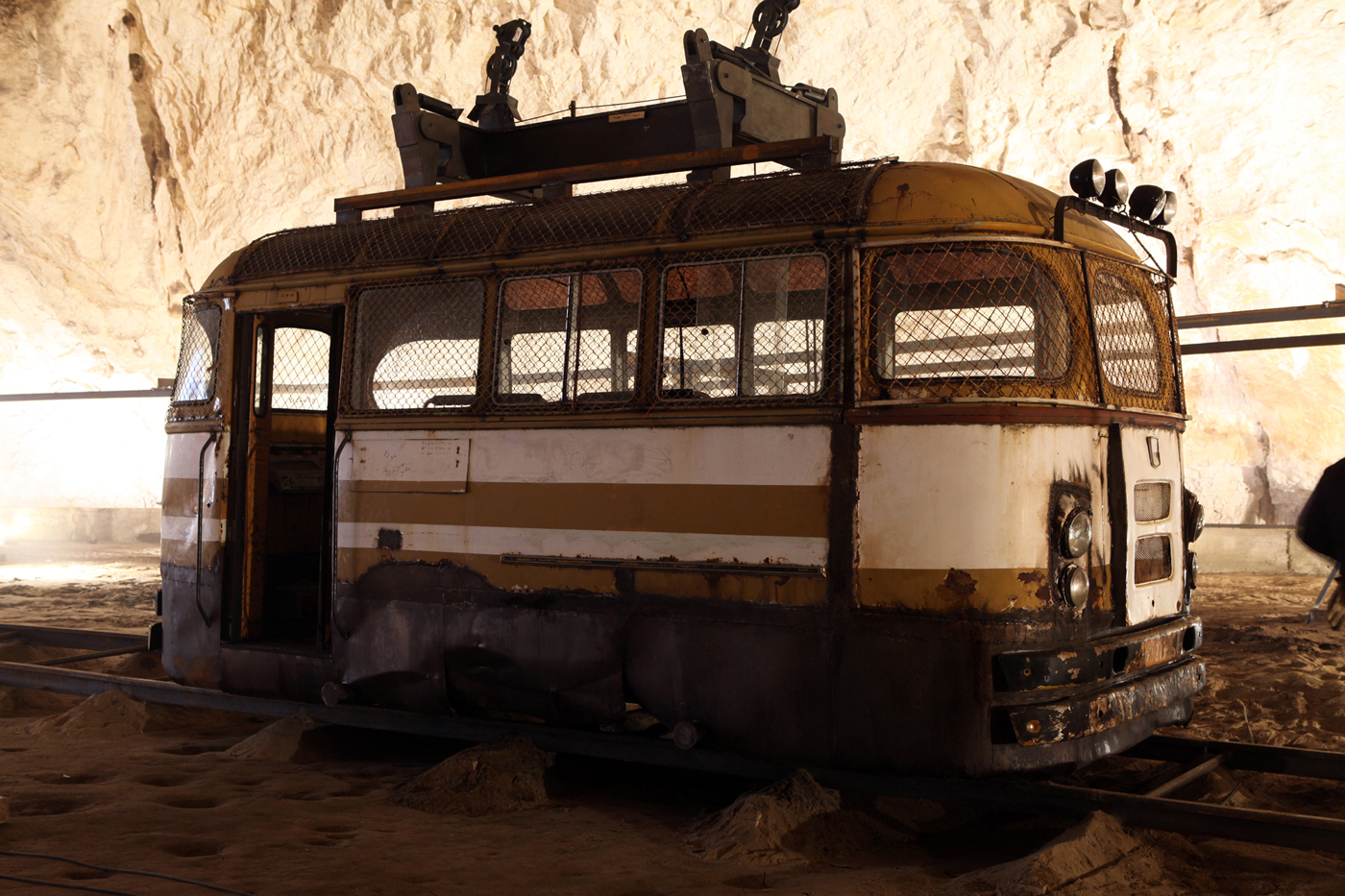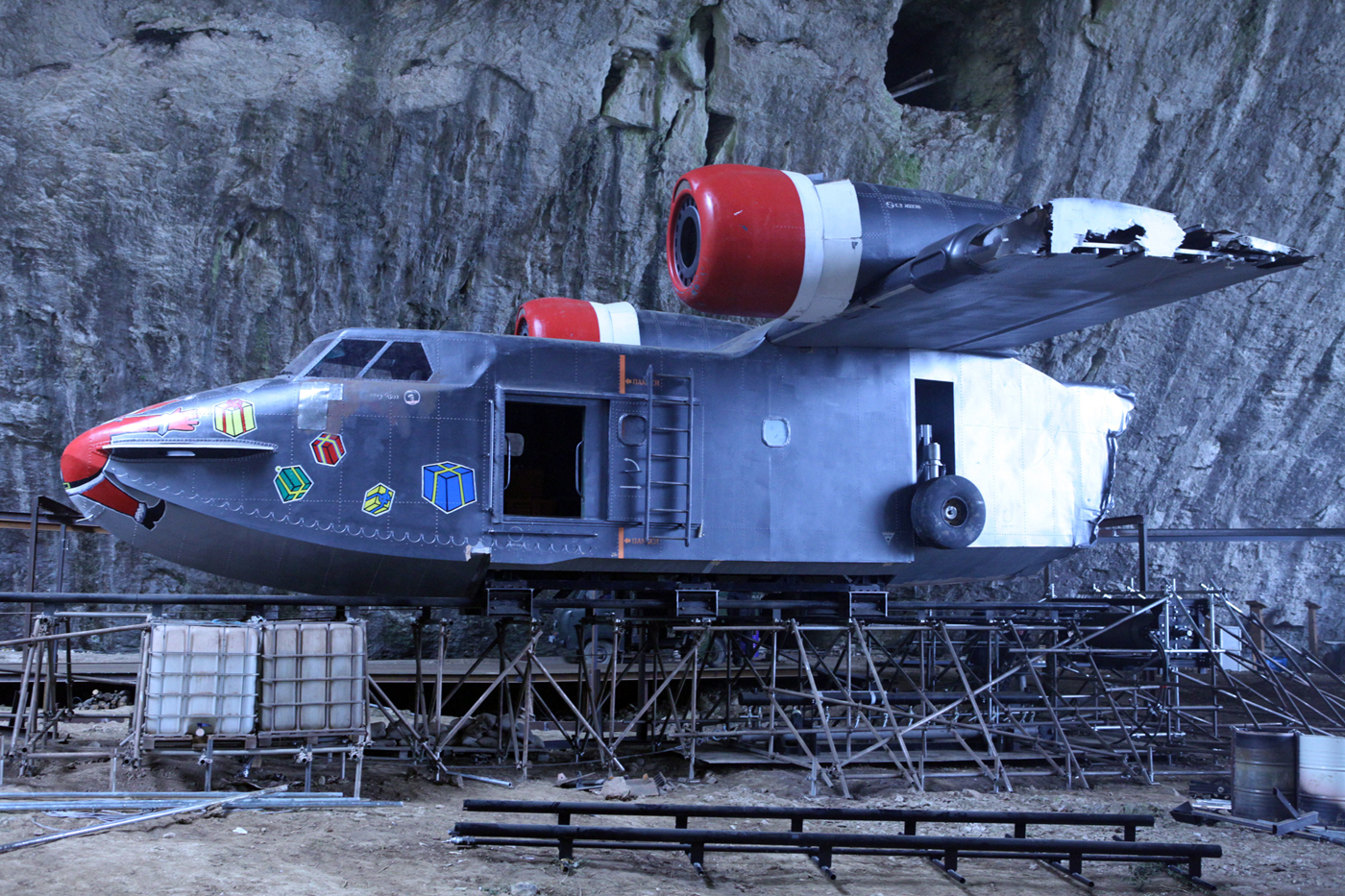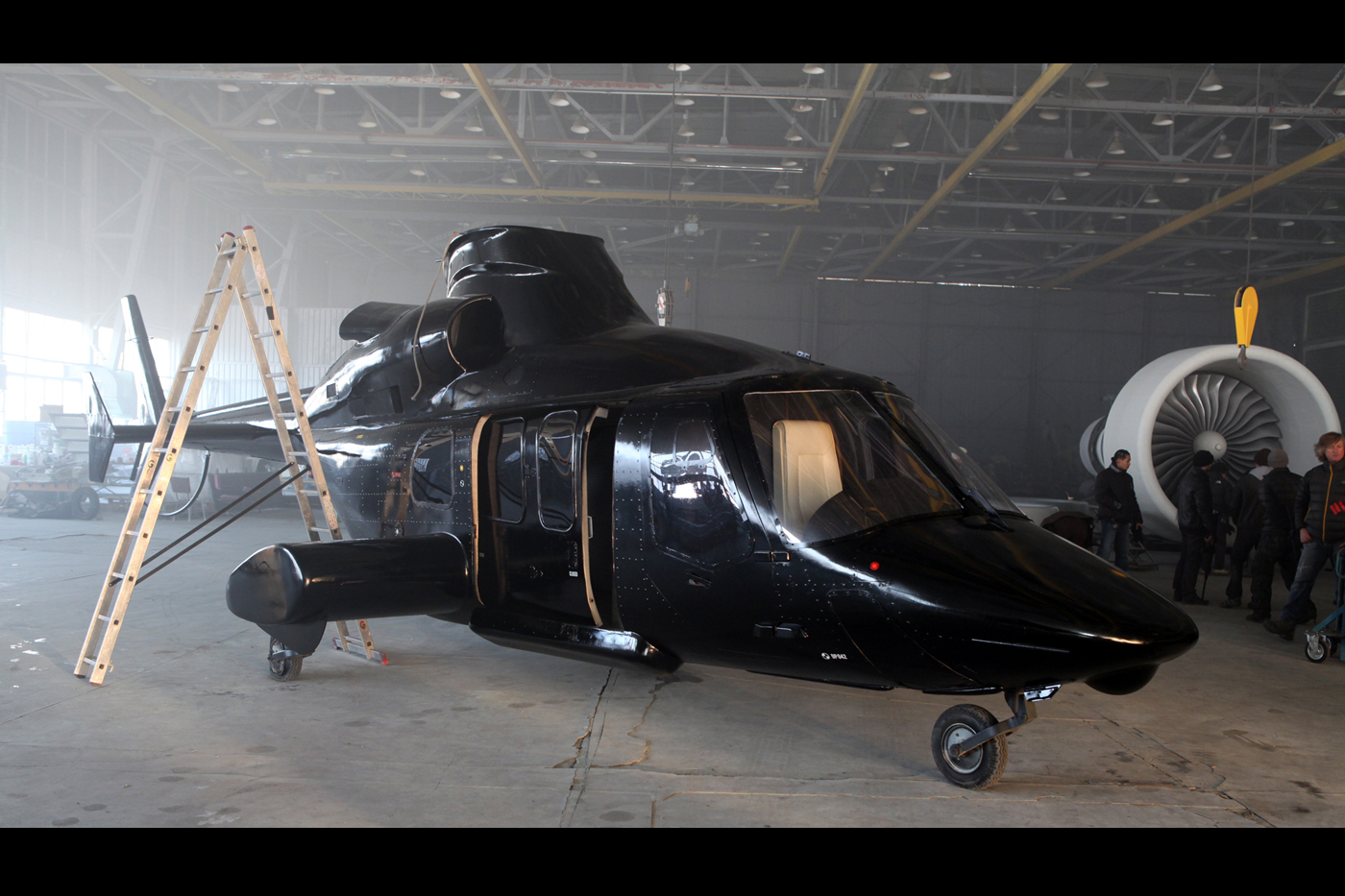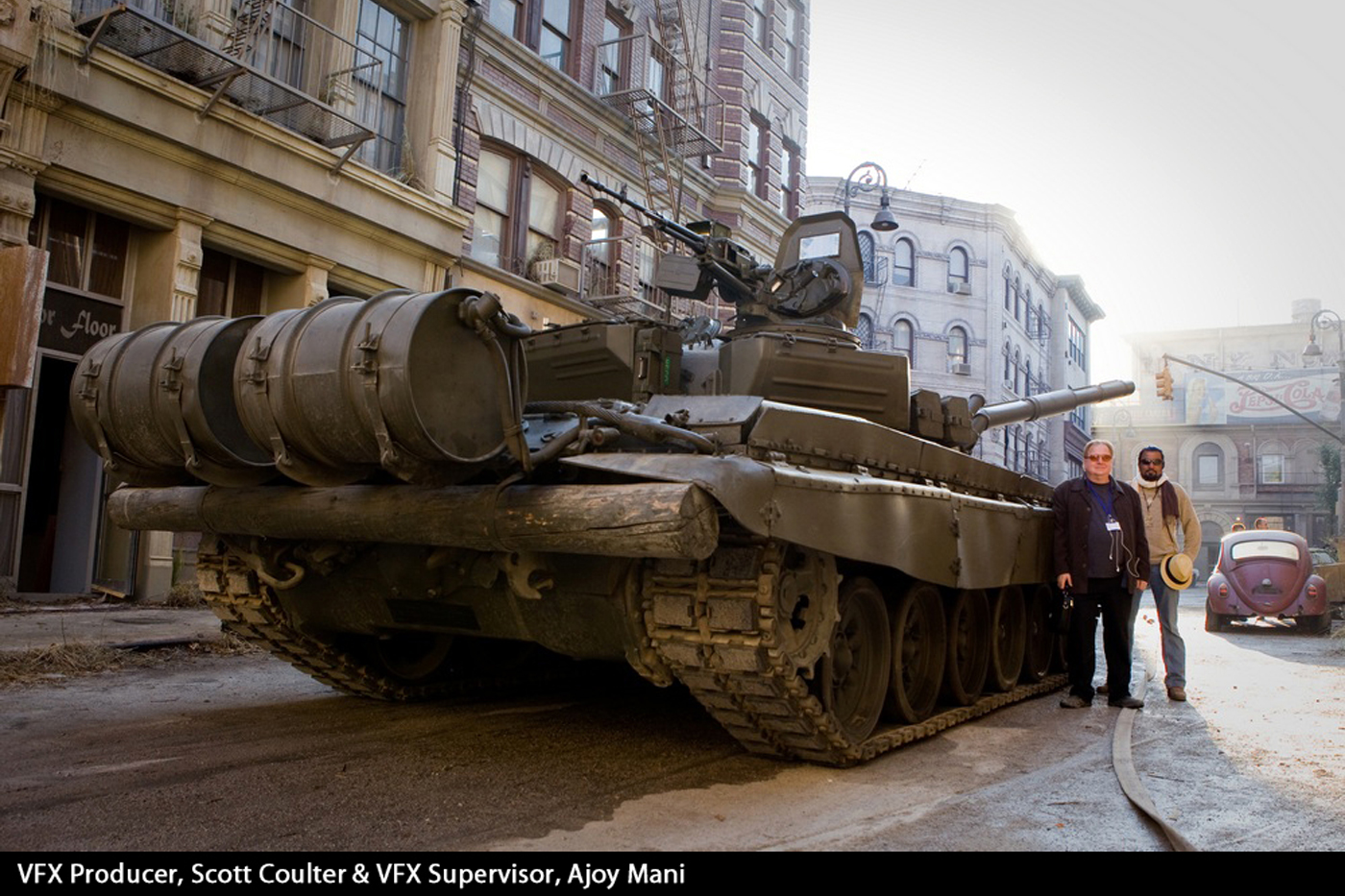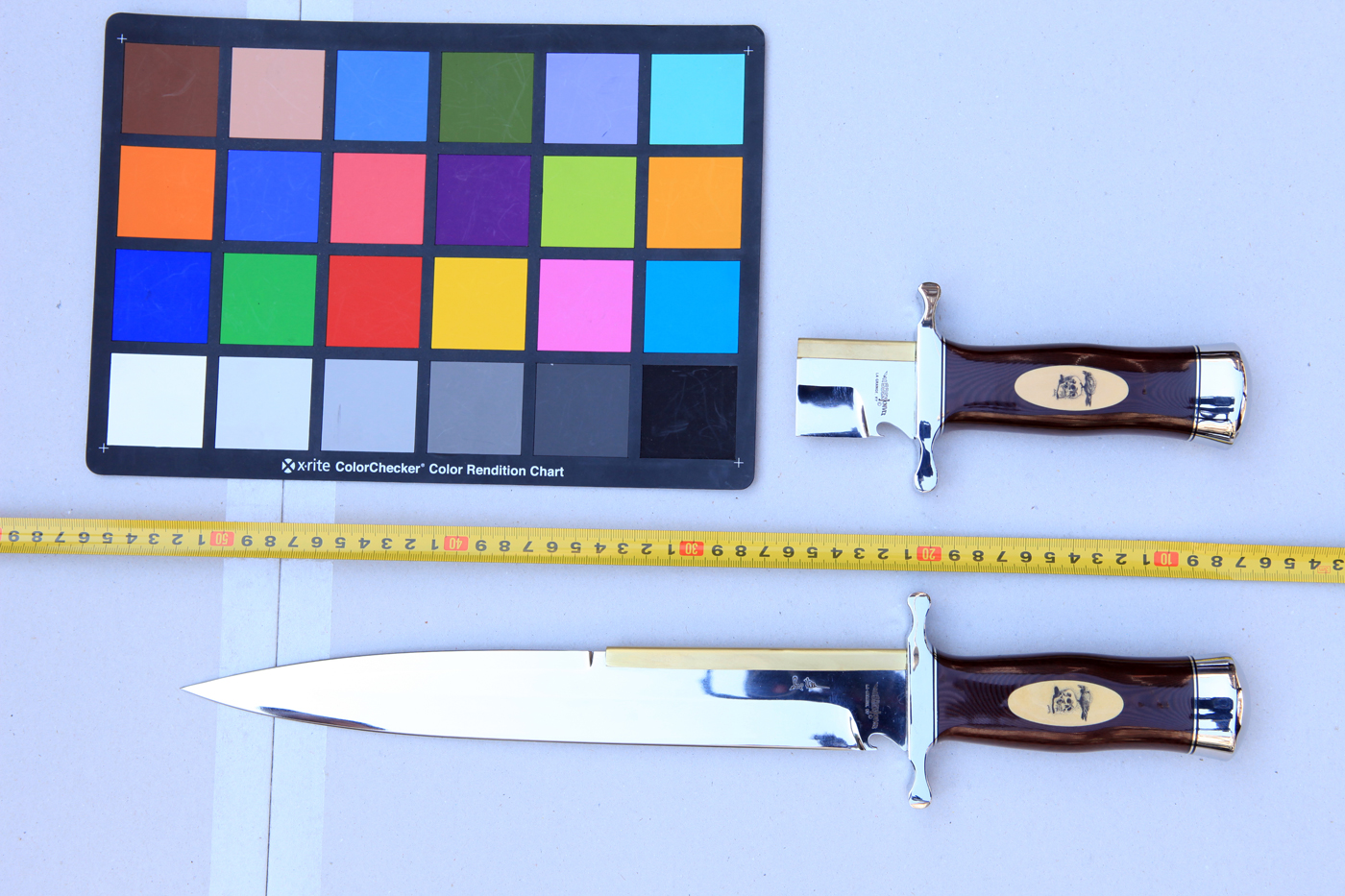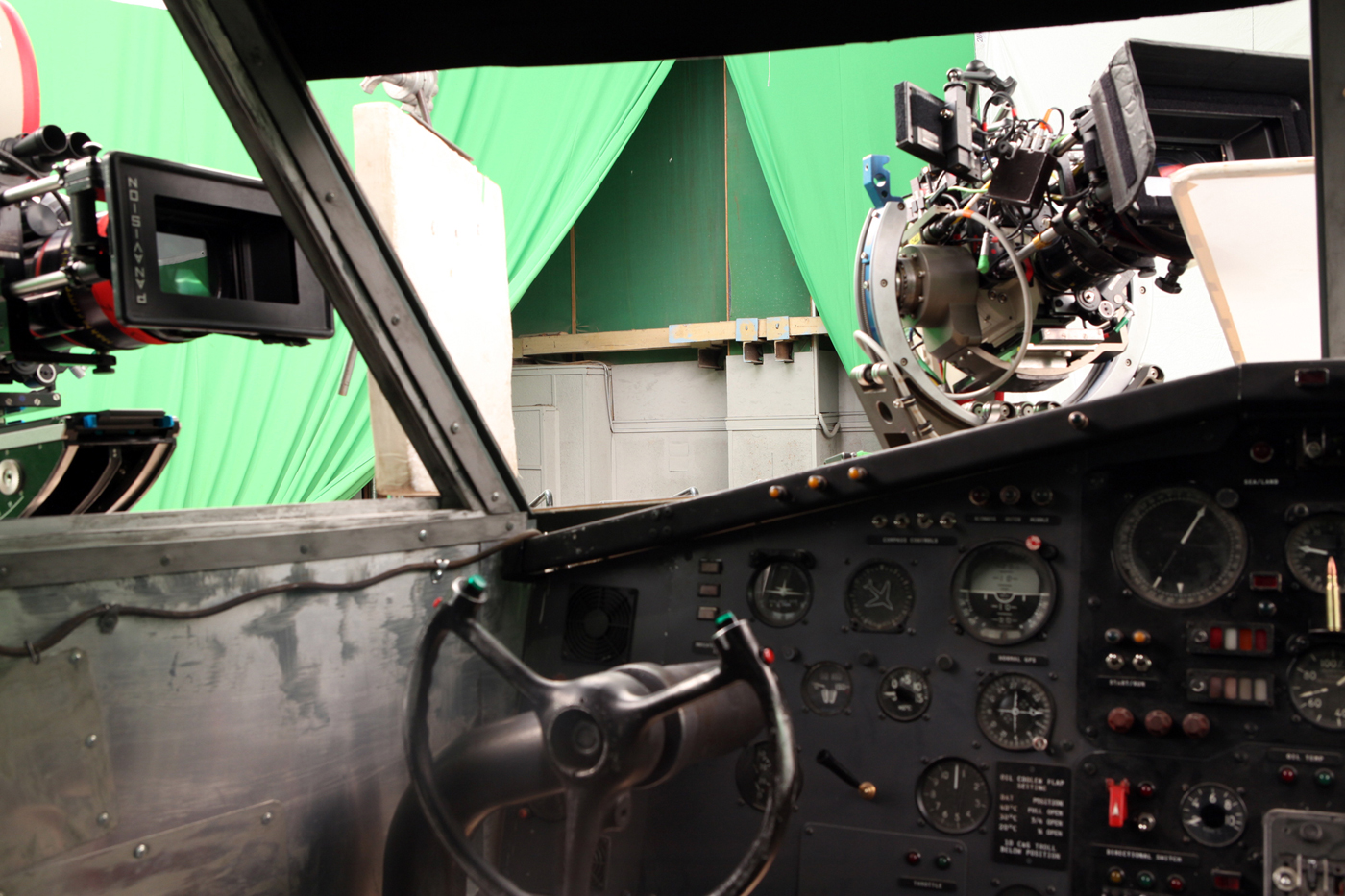Ajoy Mani is back on The Art of VFX. After explaining the effects of Worldwide FX on CONAN THE BARBARIAN, he tells us about his work on THE EXPENDABLES 2 and its many challenges.
How was your collaboration with director Simon West?
For a VFX supervisor, Simon is a great director to work with. He has an excellent understanding of the VFX process and therefore communication was a breeze.
I went to Bulgaria six weeks before the shoot for pre production. Since the movie had an unusually compressed completion time line, we had to do a lot of things in parallel including meticulously planning and starting on VFX well before the shoot. I met Simon during pre production. Simon has a very visual mind and he is very detail oriented. Since WWFX has a talented concept department with former comic book artists, we offered Simon the option to do detailed storyboards. In addition, we did a lot of animatics, especially for complex scenes like the plane crashing in the cave. During this phase, I met with Simon almost daily with the story board artists, and we fleshed out detailed storyboards. This was particularly helpful for me, as I was able to use the storyboards as a reference to do a detailed VFX breakdown and make more accurate estimates.
During the shoot, I was always within reach of Simon. As things evolved on set, I would communicate with Simon on contingency plans, options and additions from VFX. Simon is well versed in what VFX can offer him and he would constantly look for ways to get bigger results from VFX via enhancements. We built a lot of the set, vehicles and other assets digitally during production, as I determined they may come up in post. We shot extensively in Bulgaria and later in New Orleans and Hong Kong for the Jet Li sequences.
We worked together during the director’s cut phase of post production out of his editorial in Santa Monica. During this phase, VFX provided an array of options for Simon as the edit fleshed out. As we had modeled most of the assets during production we were able to create segues and options on the fly for Simon and the editor, Todd Miller. Most of these would start out as an animatic that Todd would plug in to the edit. World Wide FX (WWFX) would turn a lot of these around in less than a day. Todd would then retime and fit these in the edit. Once Simon got his fit, we would flesh the shot to finish.
What was his approach about the visual effects?
Simon has a lot of experience with visual effects. Most of his movies have had ample amounts of VFX and therefore, working with him was extremely rewarding and efficient. Since Simon has a complete knowledge of what VFX can offer him, he utilized VFX from the start. We started working with him during pre production and therefore could plan and offer a lot of options for the shoot. Simon worked very closely to the storyboards, so most of the shots were already well prepared for. We always took some safety shots for additional options at the edit stage. As production ensued, there were constant adjustments with VFX picking up the slack on set changes. Simon is constantly evaluating the entirety of the shoot and constantly juggling all the tools each department offers him for his final vision. During post he was constantly pushing for the “maximum bang for the buck.” He understood the resources involved in VFX, and why I had to shuffle certain resources to match his priorities. It was a pleasure collaborating with Simon.
The movie opens with an impressive and long action sequence. Can you tell us more about the preparation for it?
The opening sequence is by far is the grandest from a VFX point of view. Of the 1547 VFX shots in the movie, over 20% of the VFX shots were in the opening sequence. Sly and Simon really wanted the opening sequence to set tone for the whole movie, so a lot of time went into prepping for the first reel. The entire opening reel at the South Asian militia camp was first conceived by the art department to match the script. However, it was shot at four different locations. VFX provided the matte paintings and extensions to stitch it all together.
The movie opens to what looks like wastelands right outside the militia camp. This was shot in the rural farm lands just outside Sofia, Bulgaria. VFX did extensive set extensions to this to match to the story line. The opening shot is a matte painting, which establishes tropical jungles right behind the entry to the camp. The urban sprawl of Sofia in the distance was painted out, and the snowy mountains and sky adjusted to a more tropical.
Once the Expendables breach and head towards the gate, the next location kicks in. This was shot at Nu Boyana Film Center in Sofia. The back-lots were built like the encampment between the sound stages. Everything up to the Expendables zip lining is shot at Nu Boyana Studio. We worked very closely with the art department, props, SFX and stunts to make sure that we had all our options covered.
The zip-lining part is shot at a third location at a park on the west side of Sofia. Bear in mind that principal shooting started first week of September, and by the time we got to the park to shoot the zip lining sequence, most of the trees had yellow leaves or were already bare. It took a combination of prop trees and CG to get the forest to look tropical South Asian.
The final part of the opening reel was shot at a lake outside Sofia called Ognyanovo. Again, most of this was shot during the height of autumn and beginning of winter. We used a lot of matte paintings and for shots involving too big a parallax shift, jungles tracked and rendered in Vue. A lot of the plates there had snow and bare trees before the matte painters at WWFX changed the entire terrain. All the shots with Billy the Kid sniping was shot against bare rock. WWFX’s matte painters built the tropical background and interactive elements.
During this sequence, Stallone throws a moto to a helicopter. Can you explain to us in detail how were created those shots?
Originally this was designed as an SFX and props stunt. However, due to production limitations and the time frame we were all working under, the results didn’t look convincing. The motorcycle is a Rokon which is an all wheel drive motorcycle. I figured we would have to get into this part in some way, so we measured and built the Rokon in CG during production. We also built the helicopter as a backup. The helicopter is a militarized version of the MBB Bo105. During post production, it was felt that the prop helicopter felt too static and the Rokon’s flight path looked too artificial. Even with the cables painted out it looked unnatural. So we ended up completely painting out the prop helicopter and the Rokon and replacing them with full CG versions.
How was created the new Expendables plane?
The Expendables plane went from just a plane during early pre production to a supporting character. It is a Canadair CL-215. It was built as a fire fighting flying boat from 1969 to the last in the series being made in the 1990’s. It is a very impressive plane in its own right, but the movie version was militarized the Expendables way.
As the script got fleshed out more and more, the plane took on additional capabilities. Capabilities that is physically impossible. The challenge was to make the plane look like it could do all these tasks without drawing attention. For example, during the lake sequence, Simon wanted a cool way for the jet skis to drive into the back of the plane. The back of the plane is like a knife edge and this is physically impossible. Including driving up two 255HP Jet Ski’s in the back. We had to work closely with the editors to come up with a way to pull this off without drawing attention to this issue. The nose canon was designed by the art department. However, in reality there is no space to place a canon of this size in the plane, so that had to be cheated as well.
Knowing the plane had taken on the life of a character and its intentions to perform beyond its real capability, five different versions of the plane come together to form the on screen plane. We started building a CG version of the plane during pre production by working closely with the art department designs and plans. Building the CG model this early helped flag issues before construction, and gave art department and props the ability to visualize the final result. The CG model helped act as a unified reference for all the versions of the plane. This was a first for me as VFX usually is running around at the end trying to get all the versions to look the same to avoid continuity issues. This process was very helpful and efficient overall.
The five versions of the plane are:
1. Real Canadair CL215 for the wide shots of the plane flying and taking off from the water. A real plane was flown in from Turkey and painted to match the designs from the art department.
2. The team at props built an incredible, full size amphibious version of the plane. It has no propellers. So for all shots of the plane in the water, VFX added the propellers. This was used for the most part during the river chase sequence.
3. An interior version for interior shots. This was built a third bigger to ensure it could accommodate the Expendables comfortably.
4. A front fuselage section on rails for the plane crash scene in the cave. In the end, we only used a handful of shots with this and replaced it completely with the CG model. This was because the practical model just wasn’t moving fast enough on set. Even when shot at lower frame rates, the plane didn’t feel fast enough for the crash.
5. Finally, the all CG model.
Can you tell us more about the big explosions on the lake with many soldiers inside the flames?
I worked closely with SFX to figure out how to do this during production. In the end, we decided to shoot this with no dummies. It was shot with only the props. SFX did a good job with this explosion and it looked fantastic. This was shot by the second unit. They used two cameras from the outer banks and two Canon 5D’s in crash boxes. During post, this section of the sequence was in constant motion with shots being dropped and replaced until 3 weeks before delivery. The Massive team at WWFX, under Nikolay Gachev animated the soldiers getting blown up. We got the animation of the guys getting blown up worked out first. That way when we did get lock, we could change the digital camera angles and match it. This element was then comped into the explosion.
How did you create the dam structure and the environment?
The Ognyanovo Lake is a reservoir behind a dam. But, the dam is so far down from where we shot, that we could only see a bit of it or it was not visible at all. During pre production, I felt that it was imperative we capture the Lake Ognyanovo in summer when the area was still green. So, I had sent out a team to photograph and measure the banks with Total station. Danail “Dundee” Hadzhyiski, the first unit set supervisor and the data wranglers photographed all possible areas we could possibly shoot at, including the dam. The final dam ended up being a composite of the dam already at Ognyanovo and another dam site we shot at, Studena dam. The set photographs and measurements were used to build a composite dam that was then tracked and placed in the shots. The editors would choose shots based on the performance of the boat plane. We had to go in and then move the CG dam closer or further to match the feel of the plane approaching the dam.
As mentioned above, we photographed the area in summer to capture as much green as possible. A lot of this was then used to build some of the matte paintings. For some of the establishing shots, we had to completely rebuild the foliage as a matte painting to make it look tropical. All the lake shots were done in autumn or winter. For a lot of the closer shots, we rotoed around the trees with yellow and red leaves and tweaked it tropical green.
The reveal of Vilain and his team are dramatic with the strong fog. How did you create these atmospherics effects?
This was particularly difficult as the cut kept changing till weeks before delivery. We had to treat the fog sequence in a linear way so we could build the fog layers and do the reveal right. Steve Ramirez, the VFX editor and I would try and make estimates as best as we could from Editorial in LA. I would then relay to Stefan Tchakarov the VFX studio supervisor at WWFX. Based on how the cut was coming together, the shots were prioritized and individually rotoed out as layers. As soon as we got lock, Steven and I would assess the shots and then alert WWFX on what percentage to pull back the fog for each layer. This went back and forth for a while before we got it right. But, we worked as efficiently as possible under the circumstances.
We had a similar situation with the fog in the New York Set sequence when Chuck Norris reveals himself. This sequence was shot over several months under different conditions, so there was a lot of disparity in the fog levels. The shots had a lot of practical fog in it, we had to add to each and balance it out so it read the same.
The movie features an impressive number of various environments. What references did you received from the production and how did you create these environments?
We were working on a compressed timeline for finish and Scott Coulter; the VFX producer had me brought out to Bulgaria early during pre production. This turned out to be very helpful as I was able to go on all the location scouts. This helped me plan out the reference shoots well before principal photography started. I had set photographers and data wranglers at all the locations. We used a combination of a Total station and photogrammetry to take reference. We had take photographs for two purposes; first for photogrammetry, which requires a parallel path to the surface, and the second for textures. The cave by far was what we spent the most time taking reference images of. The Devetashka cave is a protected cave and therefore, I knew we would lean a lot on the CG model. The reference and measurements are a passive process, so we spent a lot of time here.
For the props and studio sets, I was in daily contact with the art and props department, and as I would see designs being approved by Simon, I would have it sent over to WWFX to start modeling. In return, as soon as the models got done, I would offer that to the art and props department should they need it for visualization. We used photogrammetry on the studio sets, even on the ones which didn’t at the time seem to need any VFX. It turned out to be a good idea, as we ended up doing a lot of segue shots using this information. All the weapons used were also meticulously photographed and measured.
Can you tell us more about the huge cave in which Vilain searches for the plutonium?
The cave is a combination of a real location at the Devetashka cave and a studio set. The Devetashka cave is a network of caves that is 2.5Km deep and the cave roof as high as 60M in places. It’s the biggest cave I have ever seen. It was not known to modern science till the 1920’s. It has had human habitation for over 70,000 years from early Stone Age to Roman era. It also houses a massive colony of bats and numerous species of birds. During WWII, the Nazi’s used it as a fuel bunker. It is so massive; their container trucks would drive into it. In order to facilitate this, they built a bridge from across to the river to it. The Soviets destroyed it when they over ran Bulgaria. Production rebuilt this bridge so we could access it. All in all, this is a very sensitive area. As a result, production was careful to limit the lights in the cave and explosions and gun fire was not allowed. This put a lot of restrictions on SFX and other departments.
Knowing this, I knew a lot of this would fall on VFX. The vault area of the cave was shot on a studio set. So we had to come up with a way to marry the two. We took extensive reference images and measurements of the cave so we could rebuild it in CG. This part of the movie was also being tweaked till weeks before delivery. The size of the vault area kept changing; we would mockup the cave to serve the cut, and then wait for approval before we patched in our new version. WWFX built a composite whole of the entire cave with the vault and the cave subway car (dubbed the Travelator) and started adapting it as the cut came along.
All the massive pillars in the cave are CG as well. The ones where we see the Expendables saving the workers were shot on a sound stage. But, they were only 6M high. The rest is all CG extensions. The two massive pillars at the entrance of the cave were also just 6M high and CG extended all the way to the cave ceiling.
What was the real size of the cave sets?
The Devetashka cave system is quite extraordinary. The entrance alone is 35M wide and 30M high, about 40M in; the ceiling hits 60M high! In some places the ceiling is 100M high. About 200M in, the cave split into two arteries. The one to the left is over 2Km long.
The plane crash happens in the section before the cave splits. The artery on the left is where we see Vilain dismount from his black Range Rover and onto the cave subway car (aka the Travelator). The story called for a massive concrete wall cutting off the artery from the main cave. The story point was that Vilain dynamited through this and found the hidden vault. Due to the sensitivity of the cave, there are weight limitations on construction. Only the first couple of meters of the concrete wall was built. All the rest is CG set extension. Including the dynamite scoured opening.
What were your references for the cave subway and how did you create it?
An actual Travelator was built during production. Props and art department cut two vans and built the Travelator. It was supposed to be reminiscent of a 1950’s design. During production, as soon as I got wind of the Travelator under construction, I sent a team out to measure and photograph it. By the time production was over, WWFX had built a detailed CG replica of the production Travelator.
During production there were restrictions to putting rails in the cave to move the Travelator. As a result, we ended up entirely painting out the production Travelator and replacing it with the CG one. Both the exterior shots of the Travelotor traveling in the cave are 100% CG. WWFX did an amazing job merging the CG Travelator with the live action footage. It was painfully roto intensive. The pylons and power cables for the Travelator are CG too.
Can you explain to us in detail the creation of the plane crash into the cave?
The cave crash was always the sequence we pegged as the most VFX complex. During pre production, we first storyboarded the entire sequence with Simon. After Simon approved the storyboard, we did a flat shaded animatic version of the plane crash so that we had a visualization of how it would look.
Originally, I had designed the impact part of the plane crash to be a third scale miniature shoot. In order for this to work, we would digitally wrap the cave behind the miniature, so the miniature was to be shot in a sound stage with green screens. The idea was to use a combination of the CG plane and the real one for the flight up to the cave mouth and pick up the crash with a miniature. The part where the plane’s front section drags through was going to be a section that would run on rails in the cave.
Due to production constraints the miniature shoot was cancelled, which meant the sequence now relied heavily on CG. As a result, as soon as the production was complete, we prioritized the model of the plane and the cave to be finished. As soon as post production started, Simon sketched on a map of the cave where he would like to have the cameras. The idea was to place cameras where we would logically place real cameras, including crash boxes. The whole crash sequence was already done as an animatic from pre production. We placed cameras as Simon marked them out throughout the CG crash zone. The animatics were then handed to Todd Miller, the editor and Steven Ramirez, the VFX editor who then cut in the CG cameras of the flat shaded animation. Once the CG animatic clips were fit into the cut and locked, we then proceeded to finessing the animation and adding details and simulations. This whole section changed numerous times and we were adding new clips up to three weeks before delivery.
In the end there are just a handful of live action shots in the cave crash. The section of the plane built for the plane crash in the cave had an issue. The plane wasn’t moving fast enough and even shooting at a slower frame rate didn’t help it. So most of the live action shots were taken out and replaced with CG versions. The live action plane didn’t have matching dings and damage, so those were matched as well.
WWFX handled the entire cave crash sequence, where it was fleshed out from the animatic to finish. Between the simulations and the renders of the cave, some of the shots would take weeks to render, so it had to be done very efficiently as there was very little time to make changes. This sequence didn’t come together till a few days before delivery and was definitely one of the hardest in the movie.
Did you use models on this show?
Originally, a miniature of the plane was scheduled to be shot for the plane crash, but had to be scratched due to production restraints. The MBB Mo105 helicopter in the opening sequence was a model too, but we ended up completely replacing it with a CG one which had more articulation. The helicopter in the hanger during the Christmas/Hector fight is a shell model. The entire sequence required us to add a main rotor, a tail rotor, lights and rotor wash. This was the most efficient way to do it as the story line had the helicopter starting up and going to an idling mode. We waited till the sequence was locked and then timed the rotor’s speed and rotor wash so it looked seamless throughout.
There are a lot of smoke, fire and explosions in this movie. Have you developed specific tools for these FX?
All the smoke, fire and explosion simulations done by WWFX were done using a combination of Houdini, Real Flow, Phoenix and Maya Fluids. The cave crash and the tank explosion sims were a combination of Houdini and Maya Fluids. The falling pillars in the vault room were done using Houdini and Phoenix. WWFX is a beta tester for Phoenix plug-in for Maya which is built by the Chaos Group. Chaos Group is based out Sofia, Bulgaria as well.
We shot a lot of explosion and smoke plates, but as the cut changed, very specific behavior was required from fire and smoke. The simulation department at WWFX was working around the clock to get these assets to the compositors.
The movie ends in an airport. Can you tell us more about your work on this sequence?
The airport sequence was the second most difficult sequence. However, this is one of the few sequences where everything went according to the way it was planned and we weren’t scrambling to re invent the wheel during post production. This part of the cut relatively stayed the same, so we had ample time to work on it.
The airport sequence was shot at four different locations. The drive up to the airport and the lobby fight was shot at Plovdiv Airport. While at Plovdiv airport, I sent a photographer out to shoot numerous spherical rig, bracketed, 360 degree shots. These were then stitched together to create a light probe for 3D and a spherical or lens specific output for compositors to replace the BG for the other locations. We used the exterior of Plovdiv airport on all the other locations.
The second location was the hangar. This was shot at the helicopter and aircraft hangars in Sofia airport. This served as the exterior shot of when Vilain’s trucks drive into the hangar. The interior is where the Christmas/Hector fight occurs. Things of note on the exterior shot of this location; the aircraft parked outside the hangar is 100% CG. Plovdiv airport and the planes in the background behind the fence is a CG addition to bring the two locations together. The number 3 on the hangar door is a CG addition as well.
The third location is the Military Building in Sofia, Bulgaria. This is a commercial building that is right bang in the middle of the city. The building is surrounded by dense buildings and traffic. We had a wall of blue screen around the building. This location was used for all the shots when the trucks drive through the glass, into the airport, and then exit on the tarmac side. The compositing on this was extremely well done by the team at WWFX. They used the 360 plates we shot in Plovdiv to completely replace the exterior view so that it felt congruous. At the entry point we put in the parking lot side view and the tarmac view on the exit point.
The fourth location is a sound stage at Nu Boyana Film Center. This served as the engine repair room in the back of the hangar where the Barney/Vilain final fight occurs. Reliance Media works out of Burbank was given this sequence. It consisted of a lot of face replacements, wire removals and the addition of the chain that Barney fights Vilain with.
During production we hired Plowman Craven out of UK to send a mobile team to come on set and digitally scan all the actors, and photograph the textures. These were then cleaned up and textured by WWFX. When Reliance came on board, these models where handed over to them and they handled the face replacements during the fight sequence.
Worldwide FX had worked on the first EXPENDABLES. What are the main changes on the pipeline and organization sides?
The pipeline and organization was different ground up. Unlike the first movie which had a generous production and post schedule, THE EXPENDABLES 2 had a pre production to post delivery schedule of a year. That meant we had to work extremely efficiently and build a parallel pipeline. As soon as I was engaged during pre production, as I would see set and props finished, I would send in a team to measure, photograph and CG model it. By the time production was over, we had modeled and built most of our CG assets. In fact, a month before the end of principal photography the first few finished shots were already coming out of WWFX.
The first EXPENDABLES was mostly finished by WWFX’s Shreveport, Louisiana facility. EXPENDABLES 2 did not have the participation of the US facility and was handled by WWFX’s primary facility in Sofia, Bulgaria. I had previously worked with the Sofia facility on CONAN THE BARBARIAN and therefore a solid foundation to work with.
Though the first EXPENDABLES had a lot of effects, EXPENDABLES 2 was far more ambitious in the scale and complexity of the effects. The final product had 1547 visual effects shots. Out of which 1186 shots were done by WWFX in Sofia.
The remaining 361 shots were split amongst five additional vendors. TATA Elxsi out of Santa Monica did a lot of the green screen shots. Reliance Media Works out of Burbank handled a lot of the shots from the Barney/Vilain fight as well as some of the blood hits and explosion during the airport lobby fight. Malditochroma from Argentina was contracted some of the wire removal and background replacement shots. El Ranchito out of Madrid worked on some of the green screen shots of the interior cockpit of the plane as well as wire removals during the ZIP sequence. They also did the parachute that opens when Jet Li pops out of the plane. A few additional green screen driving shots were done by R-Team out of Sofia, Bulgaria.
The pipeline for EXPENDABLES 2 was unusual, but very efficient. WWFX is wholly owned by Nu Image/Millennium Studios, the production company. WWFX was started and run by Scott Coulter in 1999. Scott is Nu Image/Millennium’s VFX Producer. As a result, we engaged WWFX from preproduction which was a great boon for a movie made on such a compact timeline.
How did you split the work between the different vendors?
WWFX was fully engaged from the onset of the movie. We couldn’t engage the other vendors till the cut was locked, since otherwise it would be chaotic. Up to that point WWFX was working on 2360 shots for the movie. Not all of them lived in the movie at one time. Just over 800 shots were dropped and replaced with new shots just two months before delivery. WWFX had their plate full. By the time we had lock, we went over all the shots, preferably as a sequence that we could parcel out for bids. The idea was to prioritize the complex work for WWFX and take out all additional sequences that took up resources that hindered WWFX’s delivery.
After the shoot wrapped in Bulgaria, New Orleans and Hong Kong, I then moved to editorial in Los Angeles. Editorial’s core consisted of Todd Miller the primary editor, Nathalie Samanon the post supervisor, Steven Ramirez the VFX supervisor, Adam Duthie the assistant editor and me. In addition we brought on Steve Moore as a second VFX editor when it came down to crunch time. I would communicated daily with Stefan Tchakarov the studio supervisor at WWFX and keep him abreast of movements at editorial. Stefan and I fed off the same database and were constantly adjusting resources and play according to movements at editorial. The cut was not locked till two months before delivery, which made it difficult for us to engage outside vendors. Until the cut was locked, the show was entirely handled by WWFX. Once we had the cut locked, within a week we had engaged all five vendors. All assets and work till that point was then handed over to the vendors. All finished shots came into editorial where we cleared them out once they passed 2K screening.
How was the work organized between the various branches of WWFX?
WWFX in Sofia is housed in a massive cold war era building on the Nu Boyana Studio Lots. The studio’s day to day operations are run by Jordan Markov and the studio is supervised by Stefan Tchakarov.
During pre production I worked primarily with the art and concept department under Simeon Asenov. Two of the concept artists, Pavel Bayraktarski and Svetoslav Hristov, did all the storyboards and we worked in conjunction with the art department in a symbiotic way. Once we started on animatics, the CG department under Dobri Georgiev came on board. As we started getting more plans and materials from the art department, the CG department started to model and texture them.
During production, I had two set supervisors. Danail “Dundee” Hadzhiyski with the first unit, and Nikolay Gachev with the second unit. Nikolay also heads the Massive department. Each team had a data wrangler and we had a visual effects coordinator. In addition, we had a set photographer. This entire team came from WWFX as well.
Right before principal photography started and I had a good idea of the scope, the project manager Radoslav Misarokov and his project coordinators started fleshing out the database. The VFX coordinator department was led by Nikolai Peshunov, who I was in constant contact with throughout the project.
Once shots were broken down, it then went to the sequence lead attached to the shot. The four sequence leads are Danail Hadzhiyski, Nikolai Gachev, Stanislav Dragiev and Alexander Valev. They would then seek out the departments to get the assets required for compositing.
If it required 3D elements it would go to Dobri who would then parcel it out to his sub departments. Modeling would go to the modeling department under Ivaylo Ivanov. For animation, it would go to the animation department under Kamen Stoykov. Texturing happened at the texture department under Georgi Gavanozov. The Layout department is headed by Svetoslav Petkov. The lighting and rendering department is headed by Angel Ivanov.
Starting with CONAN THE BARBARIAN, WWFX started a digital matte painting department. For EXPENDABLES 2, Metin Gungor who also worked on Conan supervised the digitial matter painting department.
Tracking was then sent to the tracking department under Peter Tomov. Once tracking was complete, the shot then went to the compositing supervisors Kremena Ganeva, Petar Keranov and Delyan Ketipov. Once the comps were at a point where they got preliminary approval, the simulation department under Boyan Stoyanov kicked in. Simulation is so render and resource heavy that this was started only after we had at least a soft lock on the shot. The compositors relied heavily on the Rotoscoping department under Dobromir Hristov, whose team painstakingly took the plates apart into layers. Finally once a shot got 2K approval, it went to the dust busting department under Krasimir Mayorov who made sure the frames were ready for film out. The I/O department handles the shipping and electronic transfer of all files.
All of this is held together by WWFX’s proprietary VFX management software, TRAK, built by its own tech department headed by Peter Marinov. The IT day to day is managed by Nikolay Kondarev. Trak is the most sophisticated and complete VFX management software I have ever used. I had total access to the entire pipe from editorial and I could coordinate and fine tune everything in conjunction with Stefan via this system. A powerful tool that helped me manage the whole delivery with just a couple of VFX editors from editorial. My VFX coordinator in charge of vendors, Yana Georgieva was based in Bulgaria, but using Trak and email, we were able to manage this with no issues. We had vendors on three continents and in five countries for EXPENDABLES 2; Bulgaria, India, Argentina, Spain and US.
What was the biggest challenge on this project and how did you achieve it?
In this type of film making, VFX is the glue that keeps it all together. If there is a lapse by any of the other departments, it automatically becomes a fix for VFX. It’s the last line of defense. Even during edit, when there are story line adjustments, I would offer full CG construct shots as segues. My biggest challenge was to make it my business to know what all the other departments are doing. Since I am left with the final pieces in editorial, I see things globally. For example if there are five action versions of the plane built between three departments, I felt it was imperative I get in there and make sure all of them are congruent. Otherwise, it will add numerous painful shots to the VFX bin for continuity fixes. Experience has taught me to get make it my business to make sure these continuity issues are caught as much as possible early. I would much rather focus my efforts on shots that deserve the effort. Working between the various departments without stepping on any toes and flagging issues without causing a ruckus was a challenge.
For me, technical issues are routine and somehow we always find a way to solve it. But managing people, expectations and delivery, that’s where the challenge is at. Easily the biggest challenges arise a few weeks before delivery, when finishing touches are still being put on shots. People who see the unfinished shots in preview assume this is final. Keeping cool and ploughing towards the finish line without losing my focus was definitely a massive challenge.
Was there a shot or a sequence that prevented you from sleep?
I don’t really lose sleep over work. I know I perform at my peak, and that’s really what it’s going to be. The plane crash sequence definitely had me nervous. The problem with a complex all CG sequence like that is, there are a lot of moving parts. The whole sequence was scrubbed and redone six weeks before delivery. Which meant we were starting everything from scratch on these render heavy behemoths. The sequence didn’t come together till a day before the delivery deadline. Meanwhile, everyone in editorial is nervous a month before delivery. They would look at the work in progress and be concerned. I would have to explain to them that it’s not even half way there, and shots like these don’t come together till critical layers, like atmosphere, simulations and color correction comes together. It’s hard to convince people about what it will look like in the future when only I can see it in my head. As a result this was extremely stressful till the final delivery. Of course, I would have loved to work another six weeks on these shots to meet their full potential. I originally had four months set aside for this sequence. But the way the cut came together, we had six weeks.
Given the time and circumstances, WWFX came through with flying colors. We had great chemistry at editorial from Todd the editor, to Nathalie the post supervisor to Steve the VFX editor; this really helped me stay on point. All the producers and especially Scott Coulter, the VFX producer was always behind me, that kind of support goes a long ways to get a good night’s sleep.
What do you keep from this experience?
Speak out early and quick. Even if I have to step on someone’s foot, its best to deal with it early during production. Otherwise, VFX gets left with the pieces to pick up. It will only end up backing up towards the end when you least need more stress. This experience has certainly clarified the need for me to be proactive during production. For example, if I see a light stand is visible in frame. Stop cameras immediately and take it out. Those valuable 30 seconds will save lots (hours/days/months) of time and money on the tail end. Great thing about THE EXPENDABLES 2 was that everyone from the director, DP, AD’s to editors had a lot of experience with VFX; they were all very cooperative and VFX sensitive.
How long have you worked on this film?
I started 28 July 2011 and I delivered on schedule on 6 July 2012.
How many shots have you done?
Total shot count for THE EXPENDABLES 2 was 1547 shots.
1186 was done by WWFX. 361 shots were the other five vendors. Additionally, 803 shots that were worked on were dropped six weeks before delivery.
What was the size of your team?
Total of 277 splendid folks!
97 from World Wide FX, Sofia
121 from Reliance Media Works, Burbank and India
20 from TATA Elxsi, Santa Monica and Mumbai
18 from El Ranchito, Madrid
12 from Malditochroma, Argentina
6 from R-Team, Sofia
+ 2 VFX editors and 1 Asst editor at editorial.
What is your next project?
I start on HOME FRONT starring Jason Statham on 21st September 2012.
A big thanks for your time.
// WANT TO KNOW MORE?
– WWFX: Official website of Worldwide FX.
// THE EXPENDABLES 2 – VFX BREAKDOWN – WORLDWIDE FX
// THE EXPENDABLES 2 – CAVE VFX BREAKDOWN – WORLDWIDE FX
© Vincent Frei – The Art of VFX – 2012




